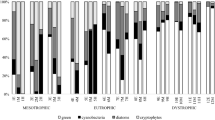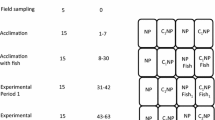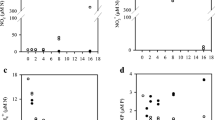Abstract
Although prokaryotes are small in size, they are a significant biomass component in aquatic planktonic ecosystems and play a major role in biogeochemical processes. A review of the recent literature shows that the relative importance of prokaryotes to material and energy fluxes is maximized in low-productivity (oligotrophic) ecosystems and decreases in high-productivity (eutrophic) ecosystems. We conclude that competition with eukaryotic autotrophs for dissolved nutrients and competition with phagotrophic heterotrophs and physical processes (sinking, photooxidation) for organic carbon (C) play important roles in determining the relative abundance and impact of prokaryotes in aquatic systems. Oligotrophic systems have low nutrient concentrations, with high proportions of dissolved nutrients in organic form, which favors prokaryotic heterotrophs over phytoplankton. Furthermore, a high proportion of the available organic C is dissolved rather than particulate, which favors prokaryotic heterotrophs over phagotrophic heterotrophs. In eutrophic systems, increased relative concentrations and loading of inorganic nutrients and increased relative concentrations of particulate organic C select for phytoplankton and phagotrophic heterotrophs over prokaryotic heterotrophs. Increased particle sinking fluxes and/or decreased excretion of organic carbon (EOC) may also decrease the relative importance of prokaryotic heterotrophs in eutrophic systems. In oligotrophic systems, interactions between autotrophs and heterotrophs are tightly coupled because the dominant heterotrophs are similar in size and growth rates, as well as having similar nutrient composition to the dominant autotrophs, small phytoplankton. In eutrophic systems, increased productivity passes through zooplankton that are larger and have slower growth rates than the autotrophs, leading to a greater potential for decoupled auto- and heterotrophic production and increased export production.
Similar content being viewed by others
Author information
Authors and Affiliations
Additional information
Received 18 July 2000; Accepted 13 September 2001.
Rights and permissions
About this article
Cite this article
Cotner, J., Biddanda, B. Small Players, Large Role: Microbial Influence on Biogeochemical Processes in Pelagic Aquatic Ecosystems. Ecosystems 5, 105–121 (2002). https://doi.org/10.1007/s10021-001-0059-3
Issue Date:
DOI: https://doi.org/10.1007/s10021-001-0059-3




